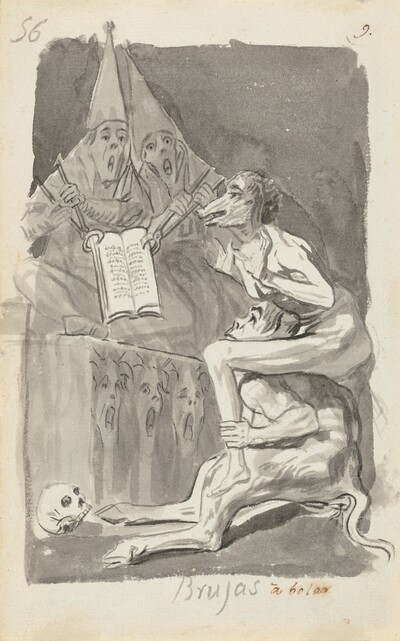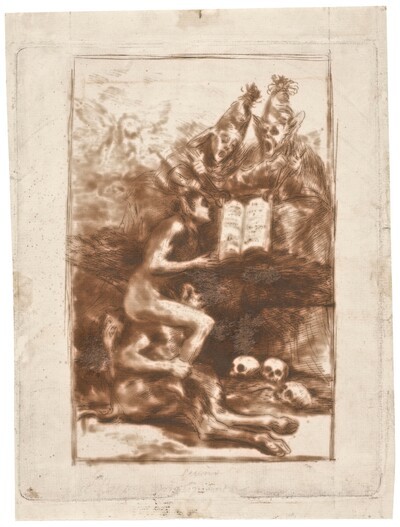- Cronología
- Ca. 1797 - 1799
- Dimensiones
- 210 x 166 mm
- Técnica y soporte
- Aguafuerte, aguatinta y punta seca
- Reconocimiento de la autoría de Goya
- Undisputed work
- Ficha: realización/revisión
- 11 Jan 2011 / 29 May 2024
- Inventario
- 225
Devota profesion. (at the bottom)
70. (in the upper right-hand corner)
Goya (signed in the bottom left-hand corner)
See Francisco de Goya y Lucientes, Painter.
A state proof with aquatint that belonged to the old Sánchez Gerona collection has been preserved, as well as three preparatory drawings for this engraving (1), (2) and (3).
A young, long-eared apprentice witch is mounted on the shoulders of a satyr sitting on his goat-like hindquarters on the ground. In front of her, standing tall, are two large-eared figures wearing mitered, sharply folded cloaks, who place a book before the apprentice and hold it in tongs. Below emerge two heads with closed eyes and half-open mouths. Both the young witch and the four figures taking part in this ceremony have a stern, concentrated attitude that speaks of the solemnity of this moment.
In the manuscript in the Prado Museum, the following is written about this engraving: "You swear to obey and respect your teachers and superiors? Do you sweep, spin cloth, play rattles, howl, howl, shout, fly, stew, smear, suck, cook, fry, every time you are commanded? I swear. Well, daughter, you are already a witch. Be in ora buena". This interpretation suggests that Goya has depicted the oath that a neophyte swears before her superiors, confirming her entry into the world of witchcraft.
The artist has used etching over almost the entire surface of the print to accurately depict the protagonists, as well as the somewhat nebulous atmosphere in which the scene is taking place, which he constructs with continuous, brief horizontal strokes.
However, as in other engravings in the series, Goya could also be suggesting another meaning for this image. It is possible to reach this conclusion by reading the interpretations provided by the manuscript in the Biblioteca Nacional and the Ayala manuscript, which allude to the speed with which some clerics were promoted in the Church. Thus the characters holding the book are dressed as prelates, one of whom wears a bat in the plume above his mitre. The tongs used to hold the book could be instruments of torture used by the Inquisition. In this engraving, Goya inverts a religious ceremony with demonic connotations, as the officiants are supported by a bird of prey with a serpent's tail, which is identified with heresy. The Aragonese artist makes a subtle, veiled comparison between the ceremonies held for those who wished to join the world of witchcraft and those held within the Church.
The plate is in rather poor condition, with the aquatint very worn (National Chalcography, no.241).
-
Goya. Gemälde Zeichnungen. Graphik. TapisserienKunsthalle BaselBasle1953from January 23th to April 12th 1953cat. 249
-
Goya. Das Zeitalter der Revolucionen. Kunst um 1800 (1980 – 1981)Hamburger KunsthalleHamburg1980cat. 40
-
Goya y el espíritu de la IlustraciónMuseo Nacional del PradoMadrid1988from October 6th to December 18th 1988. Exhibited also at Museum of Fine Arts, Boston, January 18th to March 26th 1989; The Metropolitan Museum of Art, Nueva York, May 9th to July 16th 1989, Madrid curator Manuela B. Mena Marqués, scientific directors Alfonso E. Pérez Sánchez and Eleanor A. Sayrecat. 61
-
Goya. La década de Los CaprichosMadrid1992organized by Real Academia de Bellas Artes de San Fernando sponsored by Fundación Central Hispano, Madrid, consultant editor Nigel Glendinnig. From October 26th 1992 to January 10th 1993cat. 61
-
Francisco de GoyaMuseo d'Arte ModernaLugano1996exhibition celebrated from September 22nd to November 17th.cat. 70, p.97
-
Ydioma universal: Goya en la Biblioteca NacionalBiblioteca NacionalMadrid1996from September 19th to December 15th 1996cat. 143
-
Francisco Goya. Sein leben im spiegel der graphik. Fuendetodos 1746-1828 Bordeaux. 1746-1996Galerie KornfeldBern1996from November 21st 1996 to January 1997cat. 76
-
Goya artista de su tiempo y Goya artista únicoThe National Museum of Western ArtTokyo1999from December 1st to July 3th 1999cat. 126
-
Goya e la tradizione italianaFondazione Magnani RoccaMamiano di Traversetolo (Parma)2006consultant editors Fred Licht and Simona Tosini Pizzetti. From September 9th to December 3th 2006cat. 70, p.163
-
Goya. Opera graficaPinacoteca del Castello di San GiorgioLegnano2006exhibition celebrated from December 16th 2006 to April 1st 2007p.42
-
Goya et la modernitéPinacothèque de ParisParís2013from October 11st 2013 to March 16th 2014cat. 173
-
Goya: Order and disorderMuseum of Fine ArtsBoston2014cat. 167
-
Goya engravings and lithographs, vol. I y II.OxfordBruno Cassirer1964pp.147-148, cat. 105
-
Vie et ouvre de Francisco de GoyaParísOffice du livre1970p.184, cat. 591
-
Goya, la década de los caprichos: dibujos y aguafuertesMadridReal Academia de Bellas Artes de San Fernando1992pp.100-103, cat. 59-61
-
Catálogo de las estampas de Goya en la Biblioteca NacionalMadridMinisterio de Educación y Cultura, Biblioteca Nacional1996p.111, cat. 162
-
El libro de los caprichos: dos siglos de interpretaciones (1799-1999). Catálogo de los dibujos, pruebas de estado, láminas de cobre y estampas de la primera ediciónMadridMuseo Nacional del Prado1999pp.352-355
-
ParísPinacoteca de París2013p. 238
-
Goya: Order & DisorderBostonMuseum of Fine Arts Boston Publications2014p. 255
-
Goya. In the Norton Simon MuseumPasadenaNorton Simon Museum2016pp. 42-75



